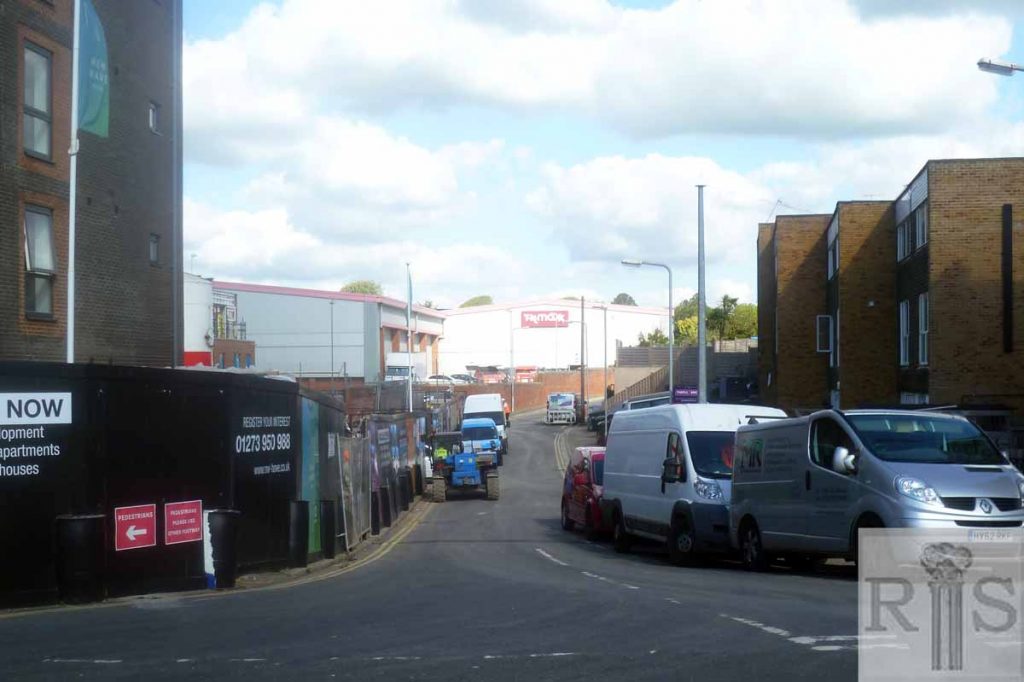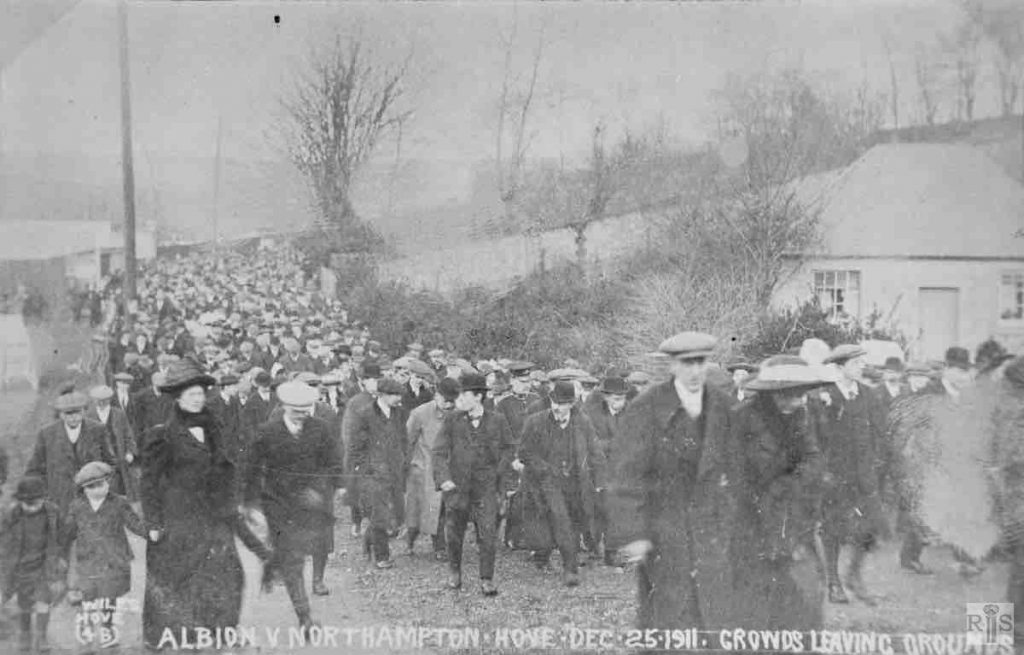
James Gray: Another view of the derelict farm cottage in the back garden of 22 Fonthill Road, with St Agnes Church and Clark’s Bakery in the background. Date: 6 December 1964. jgc_16_077
2018: Goldstone Lane is now a residential street on its eastern side. Commercial units have replaced the bakery. Goldstone Farm, owned by John Jackson Clark, grew vegetables, fruit and flowers. The cottage was occupied by agricultural workers and very overcrowded.
James Gray: The last links with the Goldstone Farm. When the farm was given up in 1930, five farm workers cottages were still standing. Only two still remain. Above, the thatched cottage in Alderman Clark’s garden unoccupied from 1930. Date of photograph – 6 December 1964. jgc_16_080
2018: The bottom of Goldstone Lane is now completely residential. Goldstone House, background right in the original photograph, was occupied from 1877 by John Jackson Clark with his wife and children. He built the model bakery nearby. (Photographer: Mark Stephenson)
James Gray: Goldstone Lane and the foreman’s cottage, the only one of eight original cottages still to be occupied. It will probably remain with us for many years to come. Photographed 21 August 1960. Goldstone Lane, the old farm road, was made up soon afterwards. jgc_16_081
2018: Viewed from across Old Shoreham Road. An eco-house has replaced the garages. The cottage was demolished when Goldstone Retail Park was built. (Photographer: Mark Stephenson)
16-091
James Gray: Goldstone Ground in August 1955, from the garden of Goldstone House. The pond behind the North goal was filled in during the late 1920s as Old Shoreham Road began to develop and the adjacent factories were built in the 1930s. The North Stand was erected by the Supporters Club in 1932 and the terraces completely concreted after the 1939-1945 War. Note West Blatchington Mill in the far background. jgc_16_090
2018: Tamplin’s, a prominent local brewery advertised on the North Stand, no longer exists. Behind this stand was a tiny police station with a couple of cells to lock up hooligans.
James Gray: This photograph shows the old farm cottage, while it was still in occupation by one of the farm workers. (It is seen in the last stages of dilapidation on other pages). As can be seen it stood at the southern end of what is now Goldstone Lane, and was passed by the crowds going to and from the Albion ground. This photograph is dated Christmas Day 1911. jgc_16_092
James Gray: This photograph shows the old farm cottage, while it was still in occupation by one of the farm workers. (It is seen in the last stages of dilapidation on other pages). This photograph was taken not long before the cottage was given up, about 1930. jgc_16_094
2018: The farm cottage has given way to urban housing. See the 2018 caption for jgc_16_077 (Photographer: Mark Stephenson)
James Gray: A last glimpse of one of the farmworkers cottages, which since 1930 had been enclosed within the garden of Alderman A.J. Clark. The garden was sold for building in 1968, and the cottage was removed soon after this photograph, dated 28 April 1968. jgc_16_103
2018: On the left a new housing scheme due to open in 2018 replaces the factory. In the middle, housing has been built on the site of the farm cottages. The church remains but in 2018 is unused pending creation of five maisonettes in the upper part and roof space with the ground and lower ground floors remaining in use as a gymnasium. (Photographer: Mark Stephenson)
James Gray: Two photographs (jgc_16_113 and 114) of this church 9 February 1975. Built in 1902, with a seating capacity of 150, it was made a Parish Church in 1927. Closed in August 1977. jgc_16_113
2018: After a period of use as a dance studio and gym, the church remains but in 2018 was unused pending creation of five maisonettes in the upper part and roof space with the ground and lower ground floors remaining in use as a gymnasium. Flats have been built either side of the church. (Photographer: Mark Stephenson)
James Gray: Two photographs [jgc_16_113 and 114] of this church 9 February 1975. Built in 1902, with a seating capacity of 150, it was made a Parish Church in 1927. Closed in August 1977. jgc_16_114
2018: See jgc_16_113 caption above. The old photograph shows the toothing for a sanctuary which was never built. (Photographer: Mark Stephenson)
James Gray: The decorated motor bus standing in Goldstone Lane outside the Albion Ground, on Saturday 16 April 1910, when the International match between the Amateurs of England and France was played here. Despite the weakness of the opposition at the time, the game was considered an unusual attraction. England was then so superior to Continental teams that the one-sided game ended with England winning by 10 goals to 1. The attendance was recorded as 3500. jgc_17_070
James Gray: This house, at the corner of Goldstone Lane, has been a familiar sight to thousands of supporters of Brighton and Hove Albion over many decades, but only the oldest of these will recall when it formed part of Goldstone farm. At the turn of the century there were seven farm cottages, six quite close to the Railway line and this larger one, which was inhabited by the farm foreman, a Mr Nye and later, a Mr Laker. When the farm was given up and the ground bought by the Albion, the house was taken into the ground perimeter.
James Gray: See caption for jgc_17_066 above. jgc_17_067
2018: Brighton and Hove Albion played their last game on the Goldstone Ground on 26 April 1977. Trees and bushes at the north-east corner of the Goldstone Retail Park, close to Burger King, now occupy the site of the old house, but the multi-gabled bungalow and more modern semi-detached houses in Goldstone Lane are still there. The backs of the taller, terraced houses on the west side of Fonthill Road can be seen behind them. (Photographer: Alan Hobden)
























